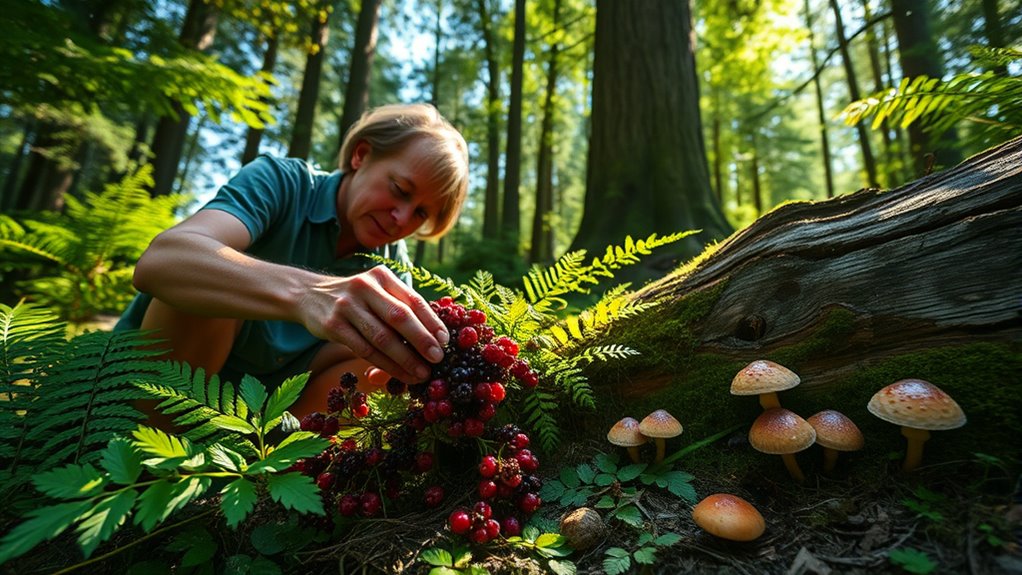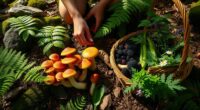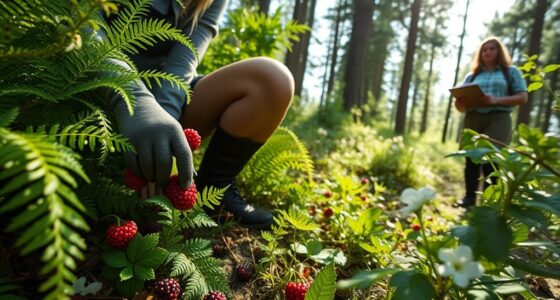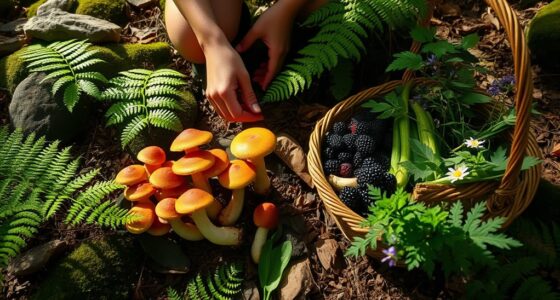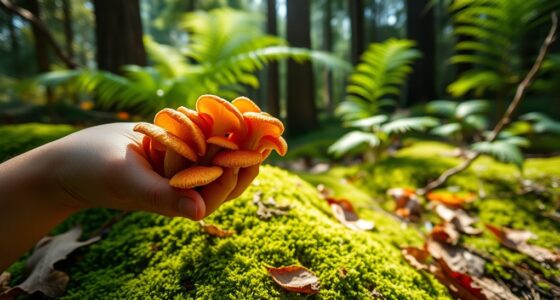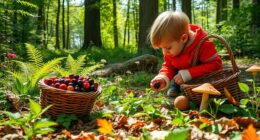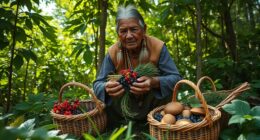Ideal Foraging Theory explains how animals choose food sources to maximize energy gain while minimizing effort and risk. It considers strategies like solitary or group foraging, decision-making based on resource quality, and environmental factors affecting success. Animals use information and experience to enhance their routes and prey choices. Various factors, including environment and evolution, influence these behaviors. To understand how these complex processes work and discover fascinating examples, continue exploring this insightful scientific approach.
Key Takeaways
- Optimal Foraging Theory predicts animals choose food sources to maximize energy gain while minimizing effort and risk.
- Animals use decision-making processes like evidence accumulation and patch leaving rules to optimize foraging efficiency.
- Foraging strategies vary based on environmental factors, resource distribution, predator presence, and species-specific traits.
- The theory helps explain behaviors in diverse organisms, from plants and insects to humans, adapting to ecological constraints.
- Limitations include assumptions of perfect decision-making and measurement challenges, affecting the accuracy of the model.
What Is Optimal Foraging Theory?
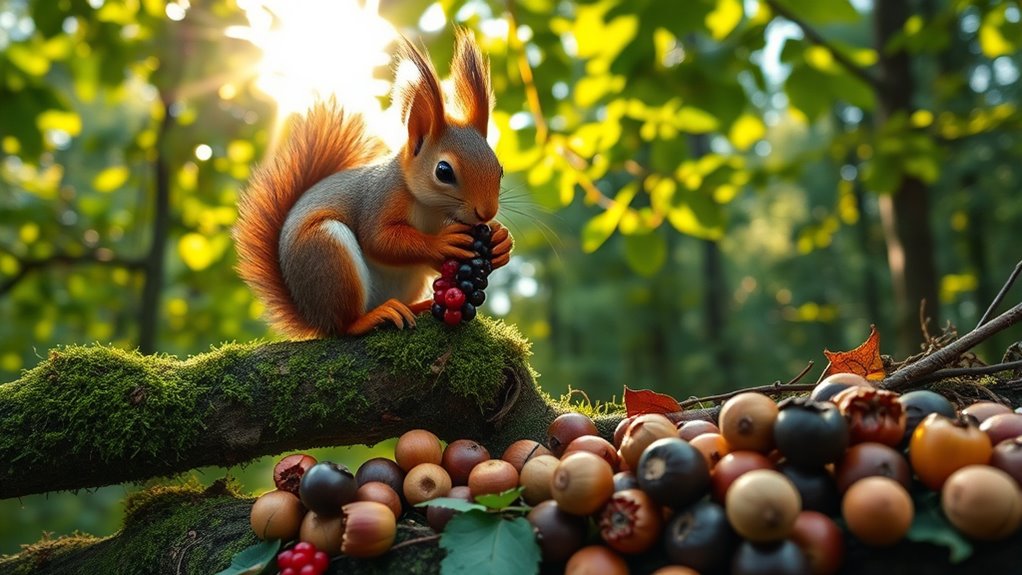
Optimal Foraging Theory (OFT) is a behavioral ecology model that predicts how animals choose their food sources to maximize their energy intake while minimizing the costs involved. You can think of it as nature’s way of ensuring animals make the most efficient choices when searching for food.
Developed by R. H. MacArthur and E. R. Pianka in 1966, OFT assumes that natural selection favors strategies that are most advantageous economically. It focuses on maximizing a benefit called the “currency,” like food gained per unit time, while considering environmental constraints. Understanding regional resources can influence foraging strategies and success. Additionally, insights from industry trends can help researchers refine their models and predictions. Recognizing how behavioral adaptations evolve to optimize resource acquisition can further enhance the accuracy of OFT models. Moreover, the availability and distribution of resources play a crucial role in shaping these strategies, demonstrating the importance of resource heterogeneity in foraging behavior. A thorough understanding of resource distribution helps explain variations in foraging tactics among different species and environments.
Core Elements of Foraging Strategies

Understanding the core elements of foraging strategies reveals how animals efficiently find and acquire food in different environments. You might forage alone or in groups, depending on resource availability and predator risks.
Solitary foraging reduces competition and predator visibility, especially in rich habitats. Some animals use tools or sensory cues, including multimodal signals, to locate prey more effectively. Additionally, foraging efficiency can be influenced by environmental factors and the animal’s physical capabilities. The presence of diverse biodiversity in an ecosystem can also affect prey availability and distribution, shaping foraging behaviors.
The foraging method varies: cruise searchers move actively through areas, while ambush searchers wait for prey to come close. Animals often adapt their strategies based on prey distribution and resource abundance. Moreover, learning and memory play crucial roles in optimizing foraging routes and reducing energy expenditure. Incorporating behavioral flexibility allows animals to modify their strategies in response to changing conditions, enhancing survival prospects.
Spatial learning helps them remember where food is found, optimizing search efforts. Additionally, portable camping gear strategies can influence an animal’s foraging success by reducing energy expenditure during search and capture. These strategies aim to maximize energy gain while minimizing costs, shaping how animals survive and thrive in diverse environments.
How Animals Make Foraging Decisions

How do animals decide when to stay in one food patch or move on to a new one? They use a combination of sequential decision-making and evidence accumulation. As they forage, they gather information about resource quality and quantity, updating their choices based on what they observe. An understanding of investment strategies can help explain how animals allocate their efforts across multiple patches to maximize energy gain. Neural circuits process this information, helping them weigh the costs and benefits of staying or moving. The marginal value theorem guides this decision, suggesting animals leave a patch when the rate of resource acquisition drops below the environment’s average. Additionally, animals often consider environmental cues and past experiences to refine their foraging decisions, adapting their strategies to changing conditions. Memory, learning, and environmental cues all influence these decisions, allowing animals to optimize energy intake while avoiding predators and managing competition. Interestingly, some species have been observed to modify their foraging behaviors based on social information, further enhancing their survival. Furthermore, the ability to learn from experience enhances their decision-making efficiency and survival prospects. Research indicates that understanding foraging environments significantly impacts how animals adapt their behaviors for survival.
Examples of Foraging in Nature

Have you ever wondered how different species find and select their food sources in the wild? Plants, animals, fungi, marine life, and humans all showcase diverse foraging strategies.
You might find wild garlic near water, harvested from late March, or dandelions for their leaves and flowers. Animals like beavers forage for aquatic plants and wood, shaping ecosystems. Foraging strategies are often shaped by environmental conditions and species-specific behaviors, optimizing food intake. The effectiveness of foraging can depend heavily on habitat conditions and resource availability, which influence how species adapt their foraging methods. Meanwhile, honeybees collect nectar and pollen using sophisticated communication. Fungi such as chanterelles and truffles are hunted with trained animals, especially in spring. Proper identification and sustainable practices are essential to avoid harming these delicate species foraging practices.
Marine foragers like crabs and mussels gather plankton and microorganisms, thriving in tidal flats and rocky shores. Humans forage for blackberries, chestnuts, and wild greens, especially during specific seasons. Additionally, innovations in foraging equipment and techniques have increased efficiency and sustainability in wild harvesting. These examples highlight how species adapt their foraging to their environment, optimizing food intake. Understanding the foraging range of different species can help explain their foraging behaviors and ecological roles.
Factors That Limit Foraging Efficiency
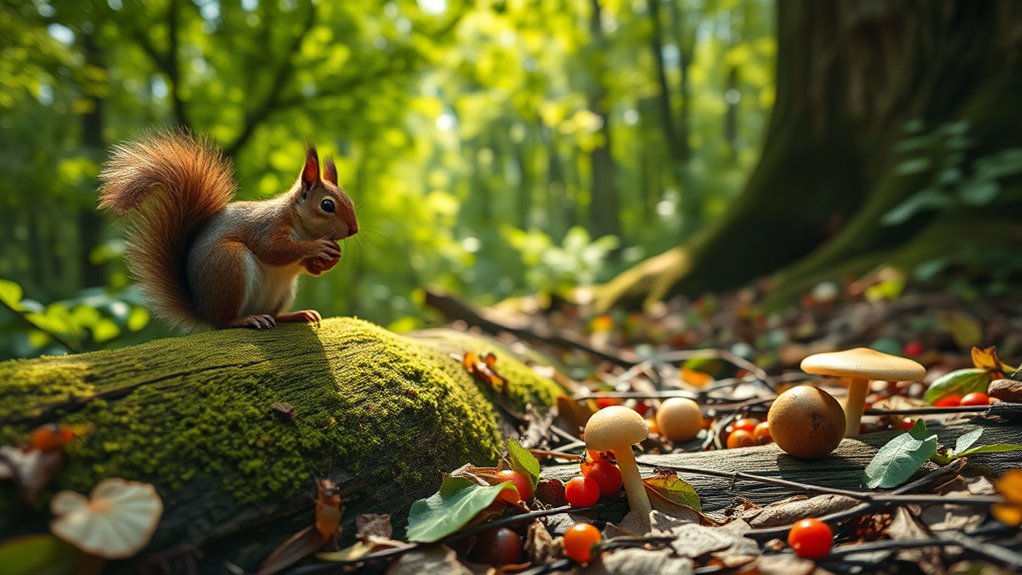
While many species have developed effective strategies for finding food, their foraging efforts are often limited by various factors in their environment and biology. Environmental complexity, like dense landscapes or physical barriers, makes locating resources harder. Scarcity or abundance of food influences how they strategize, while predators and climatic conditions can divert or restrict movement. Emotional support plays a crucial role in helping animals and humans cope with these challenges, enhancing their resilience and adaptive behaviors. Additionally, the availability and type of cooperative behaviors can significantly influence foraging success, especially in social species. Physiological limits, such as energy costs, sensory abilities, and physical endurance, constrain how much and how efficiently they forage. Cognitive factors, including learning speed, memory, and decision-making, also affect success. Social constraints like competition and territoriality reduce access to food, while cooperation and social learning can improve it. Moreover, ecological pressures from parasites, diseases, and human activity shape foraging behavior, often reducing efficiency or forcing adaptation. For example, human activity can lead to habitat destruction, forcing animals to adapt their foraging strategies. In some cases, environmental disturbances can lead to behavioral changes, prompting animals to develop new foraging techniques or shift their dietary preferences. Understanding these limitations is essential for conservation efforts and managing species in changing environments.
The Role of Evolution in Foraging Behaviors
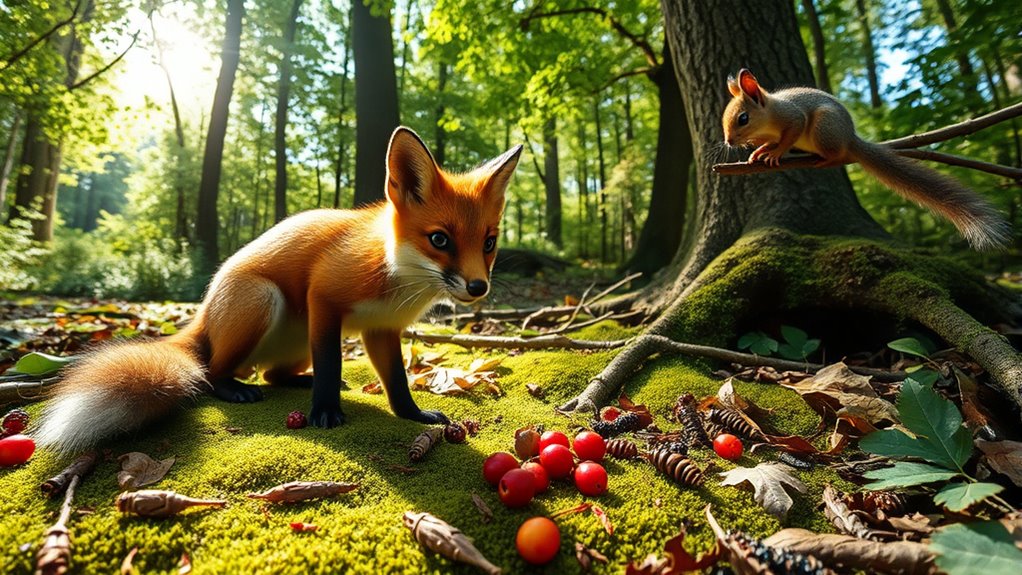
Evolution shapes foraging behaviors by driving species to develop strategies that best suit their environments. You see, environmental factors like food distribution and availability influence how species evolve their foraging methods. Genetic components, such as the foraging locus in fruit flies, play a pivotal role in shaping these behaviors. Sometimes, single genes lead to behavioral polymorphisms, affecting efficiency and strategy. Additionally, juice cleanses can temporarily influence metabolic processes, highlighting how external interventions may impact natural behaviors. Organisms adapt to spatial food patterns—whether uniform or patchy—using mechanisms like pattern recognition and genetic adaptation. Different species develop various foraging modes, such as sit-and-wait or active searching, often conserved within lineages. These behaviors evolve over time, influenced by environmental pressures, predation risks, and reproductive needs, enabling species to optimize their food intake and survival in changing habitats.
Practical Applications in Ecology and Conservation

Understanding how animals optimize their foraging strategies offers valuable insights for ecological management and conservation efforts. By studying their choices, you can develop strategies to prevent resource overexploitation and maintain ecosystem health.
Designing protected areas that align with natural foraging patterns supports biodiversity and helps endangered species thrive. Creating habitats that mimic natural environments encourages species to forage efficiently, reducing stress and promoting survival.
Managing prey populations through OFT helps prevent overhunting and balances predator-prey dynamics. Additionally, controlling food sources near human settlements can minimize conflicts, protecting both wildlife and communities.
Applying these principles allows you to foster sustainable ecosystems, ensure resource availability, and support conservation initiatives that benefit both wildlife and human interests.
Challenges and Limitations of the Model
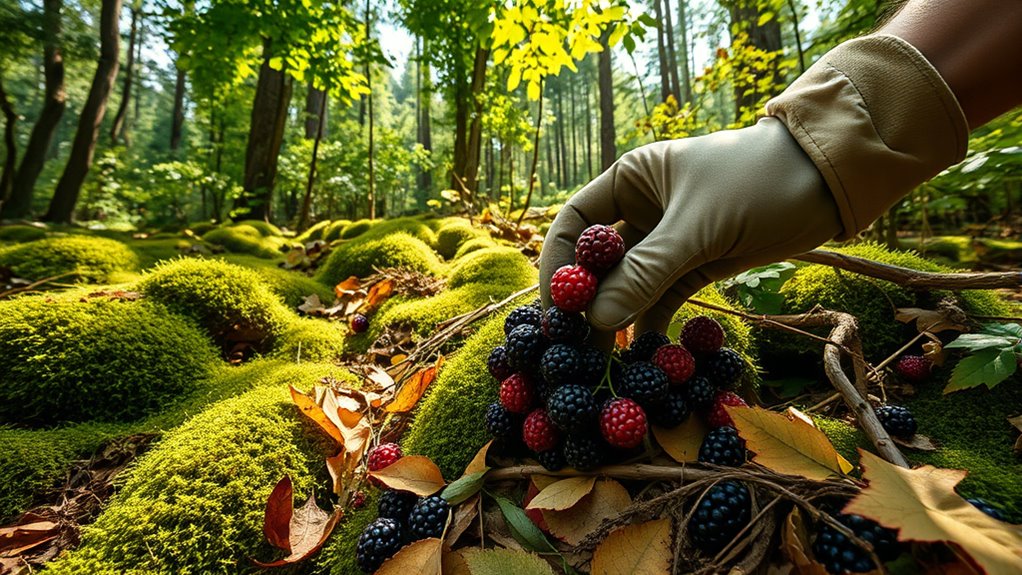
The practical application of ideal foraging theory faces significant challenges because its underlying assumptions often oversimplify complex ecological realities. You might assume natural selection always optimizes foraging, but genetic and environmental factors can hinder perfect adaptation.
The theory also presumes foraging behaviors operate independently, ignoring interactions with other activities. Simplifying ecosystems to identify optimal strategies can overlook intricate feedbacks and relationships within dynamic environments. Ecosystem complexity complicates the translation of theoretical models into real-world scenarios.
Measuring variables like prey availability or patch quality proves difficult, reducing model accuracy. Additionally, individual differences among foragers complicate empirical testing.
Evolutionary constraints, such as genetic limitations and trade-offs like predator avoidance, also influence behaviors that deviate from the model’s predictions. These challenges highlight the gap between theoretical assumptions and real-world ecological complexities.
Furthermore, understanding how dog names are chosen can reveal insights into human preferences and cultural influences that shape our interactions with animals.
The Broader Impact of Foraging Studies

Foraging studies extend beyond ecological models, influencing a wide range of social, environmental, and economic factors. You’ll see how traditional foraging shapes cultural norms and strengthens community bonds, both in rural and urban areas. However, market demand can push foragers toward unsustainable harvesting, threatening biodiversity and ecosystem health.
Ethnobiological research helps understand how foraging impacts local knowledge and resource use, guiding better policies for conservation. Environmentally, sustainable practices support ecosystem balance and biodiversity, while careless foraging can cause ecological disruption.
Economically, foraging boosts local economies through trade and supports food security in some communities. It also influences human evolution, dietary diversity, and social behaviors. Overall, foraging studies inform policies that balance cultural, ecological, and economic interests, promoting sustainable resource management.
Frequently Asked Questions
How Does Optimal Foraging Theory Apply to Human Food Choices Today?
You can see how ideal foraging theory applies to your food choices today by focusing on maximizing energy and nutrients while minimizing effort and time.
You might choose foods that are nutrient-dense and easy to prepare, like quick snacks or healthy meals, based on cost, accessibility, and personal preferences.
Cultural influences, convenience, and health goals also shape your decisions, often balancing profitability with taste and lifestyle needs.
Can Animals Override Optimal Strategies Due to Environmental Changes?
You might wonder if animals can override their ideal foraging strategies when environmental changes occur. The answer is yes.
When conditions like temperature shifts, habitat loss, or increased predation risk happen, animals often adapt their behavior, sometimes sacrificing efficiency for safety or survival. These adjustments help them cope with new challenges, ensuring they still gather enough resources despite not following the most energy-efficient approach in changing environments.
What Role Does Social Behavior Play in Foraging Decisions?
You play a key role in foraging decisions through your social behavior. Your social hierarchy, bonds, and relationships influence where and how you forage, often improving success by sharing information or coordinating with others.
You might sacrifice personal gains to maintain social ties or follow leaders’ actions, which helps your group adapt to changing environments. Social communication and strategy are essential, making foraging more efficient and reducing risks like predation.
How Do Predators Influence Prey Foraging Strategies?
Imagine you’re in a lush forest, and lurking nearby is a predator, eyes glinting. You’d naturally change your foraging habits—perhaps searching more cautiously, avoiding open clearings, or relying on your memory of safe spots.
Predators influence your decisions by making you weigh safety over food. You might sacrifice some feeding opportunities to stay alive, adjusting your search times, locations, and behaviors to survive in their shadow.
Are There Genetic Factors Affecting Foraging Efficiency?
You should know that genetic factors play a significant role in foraging efficiency. For example, in *Drosophila*, variations in the *for* gene influence behaviors like roaming and sitting, which affect how effectively they find food.
Similarly, in honeybees, specific genetic loci are linked to foraging traits such as pollen load size and foraging onset age. These genetic differences help organisms adapt and optimize their resource collection strategies.
Conclusion
By understanding the science behind foraging, you realize it’s not just about grabbing food but making smart choices that maximize gains while minimizing costs. The more you learn, the more you see how nature’s strategies are finely tuned—showing that you can’t judge a book by its cover. Keep digging into these behaviors; it’s an eye-opener and a reminder that sometimes, you’ve got to think outside the box to succeed.

